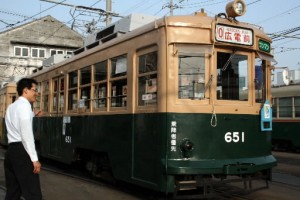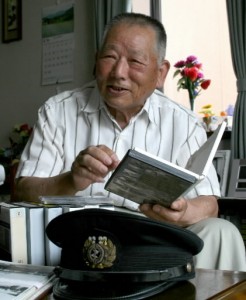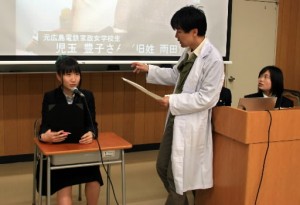Peace Seeds: Hiroshima Teens Report on Peace Issues, Part 3
Jun. 10, 2014
“A-bombed streetcars,” hope for recovery, continue to carry passengers
Hiroshima streetcars were forced to stop all service in the city in the wake of the enormous damage done to the system by the atomic bombing. However, three days later, when there was still smoke from smoldering fires across the devastated city, some streetcar lines reopened to provide service, giving the survivors hope for a recovery.
The junior writers conducted interviews with a former employee of the Hiroshima Electric Railway Company who drove the first streetcar after the bombing, high school students who are producing a radio program about that first streetcar, and the current workers who keep “A-bombed streetcars” running even today. Sixty-nine years after the atomic bombing, the A-bombed streetcars continue to convey the spirit of Hiroshima.
Two streetcars still carry passengers, used for peace education
by Takeshi Iwata
The A-bomb blast damaged almost the entire fleet of 123 streetcars held by the Hiroshima Electric Railway Company at the time. Two of these war-era streetcars, which were made in 1942, are still running on the streets of Hiroshima today. One streetcar was partially destroyed by fire near Hiroshima City Hall, and the other suffered minor damage while in Minami Ward. They were both repaired and brought back into active use the following year.
Koichi Higashi, the head of the railway company’s maintenance division, said, “We’ve kept the streetcars in use by changing worn parts, when needed. It requires a lot of effort, but we can keep using them if we do proper maintenance.” According to Mr. Higashi, the parts where wood is used, such as the floor, have been replaced a number of times.
Each time a new type of streetcar has been introduced, the A-bombed streetcars, which are small and have less power, have decreasing opportunities to run the city streets. On a regular basis, they are now used only in the mornings between Hiroshima Station and Hiroshima Port. They are also used as places for peace education about three or four times a month, where people listen to survivors’ accounts.
Akiyoshi Yamahiro is in charge of event planning for the railway company. He said, “In Nagasaki, there aren’t any streetcars from the time of the bombing. We plan to take good care of them, not only as a tourist attraction, but also as a moving heritage of the bombing of Hiroshima.”
Driver first streetcar after the bombing stopped frequently for safety checks
by Nako Yoshimoto
Only three days after the atomic bombing, the streetcars of Hiroshima resumed operations. The “first streetcar,” as people called it, lifted their hopes for the city’s reconstruction. The initial test run was made by Masao Yamasaki, now 85, a resident of Hatsukaichi, a city near Hiroshima. Back then, he was an employee of the Hiroshima Electric Railway Company.
On the morning of August 6, 1945, Mr. Yamasaki was about to leave Koi Station (today’s Nishihiroshima Station) for home after working a full day and night. “There was a flash, the station building was jolted, and shards of window glass went flying through the air,” he recalled. Fortunately, he was not seriously injured, so he could devote himself to the relief efforts.
Three days later, streetcar operations resumed between Koi and Nishitenma. No other driver was available, so Mr. Yamasaki, who had experience operating a streetcar, made the first test drive. After covering a short distance, he had to stop for a safety check. This process was repeated many times, and it took half an hour to travel about one kilometer.
“At the time, I was just afraid that the railroad bridge might collapse,” Mr. Yamasaki said. “But later people said that the first streetcar was a symbol of hope, and now I feel proud.”
Mr. Yamasaki had kept his A-bomb experience to himself for 59 years following the war, because there was discrimination and some people did not want to marry A-bomb survivors. However, he came to feel that “We must be the last victims of atomic bombs,” and began sharing his experience. I believe we must keep Mr. Yamasaki’s feelings in our hearts and carry them into the future.
Broadcasting Club creates new way of conveying A-bomb memories
by Ayumi Uehara and Nozomi Mizoue
Members of the Broadcasting Club at Itsukaichi High School, located in Saeki Ward, Hiroshima, began producing radio programs about the A-bombed streetcars two year ago. Now they are working on a program for a broadcasting contest. The program features the granddaughter of a woman who was a student when she drove one of the “first streetcars.” The granddaughter made a manga story about her grandmother’s experience. Members of the club are now preparing their program to do well in the nationwide contest.
The title of their program is “Sharing Memories: The Story of a Girl Who Encountered the Atomic Bombing.” It was created after members of the club interviewed a person who made a manga story and published it on the Internet under the pseudonym “Kanabun.” The program, which shares the manga artist’s feelings that the story had to be told, conveys memories of the A-bomb attack in a new way.
The program lasts 90 seconds. “We carefully selected what we wanted to express to produce this program,” said Yuki Tanaka, 17, the leader of the club. Club members are now undergoing intensive training with Tsugumaro Nimiya, 41, the teacher guiding the club, to prepare for the nationwide high school cultural festival scheduled for July.
The Broadcasting Club learned about the “first streetcar” when members were gathering materials about a streetcar station building which is located in Hatsukaichi. They then made a radio program about the streetcar. Yuki said, “I feel a strong sense of responsibility to tell this story to others. By taking part in the nationwide contest, I hope more people will share in the memories of the atomic bombing.”
Junior Writers’ Comments
I’m impressed that streetcars which were damaged in the bombing are still running, without showing a hint of that damage. Though we have fewer chances to actually see them running now, I hope someday I can ride in them as a passenger. (Maiko Hanaoka, first-year high school student)
This was the first story I worked on as a junior writer. It was a rare and precious opportunity to be able to hear from the person who actually drove the streetcar. I sensed the survivors’ deep sorrow and anger behind the words that they must be the last victims of an A-bomb attack. I hope to hear more stories directly by talking to more people. (Nako Yoshimoto, third-year junior high school student)
(Originally published on June 10, 2014)










